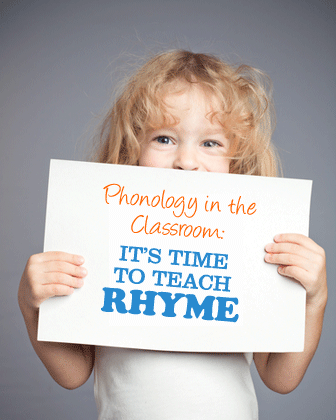For the ESL student, rhyme has great value. Learning about rhyme will increase the awareness your students have of English phonology, which is essential for pronunciation and phonics.
Speakers of languages with different phonetic make up than English will find it especially important to learn the appropriate and complete set of sounds in English. Not only that, understanding rhyme and the sounds that make it possible are necessary before a student can become a fluent reader.

How to Teach Rhyme in Your Classroom
-
1
Rhyming with TPR
TPR, or total physical response, is an ESL teaching method which teaches by associating physical movement with foreign language learning. You can use TPR techniques with your students when practicing rhyme. Walk around your classroom reading two words at a time, some rhyming pairs and others not rhyming. When your students hear a pair that rhymes, they should jump up from their seats. Have your class take their seats again and listen for the next rhyming pair. This activity can be a fun game for your students as they listen and physically respond at the appropriate times.
-
2
Rhyming with Literature
Dr. Seuss is one of the most beloved authors of our time as well as a master of rhyme. You can do several activities with his work that challenge your students understanding of rhyme. One simple option is to photocopy a few pages from his books, pages that have several rhymes on them. Then white out one word of each rhyming pair. Challenge your students to see if they can fill in words that will complete the rhyme. Following Dr. Seuss’ example, allow students to make up their own words to complete a rhyme even if it becomes nonsensical. You can then read the actual text out loud to your class and have your students see how many words they chose the same as the doctor. This is also a good time to mention rhythm and rhyme when it comes to English sentences.
In a similar vein, nursery rhymes can be employed in the same manner. These childhood classics use rhythm and rhyme to tell short stories that kids love. Try reading one aloud and pausing whenever a rhyming word is needed, and see if your students can supply the missing word. For example, you may start, “Hey diddle, diddle, the cat and the…” encouraging your students to shout out any words that might complete the rhyme. Use the classics “Twinkle, Twinkle Little Star”, “Jack Sprat Could Eat No Fat” and any others that come to mind. You may even want to copy and distribute copies to your students allowing them to illustrate their own classroom nursery rhyme book that you can later compile.
-
3
Rhyming with Games
Rhyming just might give you the excuse to bring some silliness into the classroom. You can declare a rhyme day in your classroom when you start the rhyming fun off by calling your students by rhyming names rather than their actual names. As you call attendance, call out a name that rhymes with each of your students’ names, and challenge them to respond. If you cannot think of a rhyming name for your students, simply make one up. Your students will still understand the concept even if you have to make things up to meet the rule. Then, continue your day by calling students by rhyming names, and encourage your students to do the same.
Another easy rhyme game you can play is a rhythm-based circle. Have your class sit on the floor with legs crossed and start a percussive rhythm. With a four beat pattern, slap the legs twice, clap once and then do nothing on the fourth beat. This fourth beat is when you will say a word that your students will have to rhyme. For example, (slap, slap, clap) “Boy!” The group would continue (slap, slap, clap) and the next person would say, “Toy!” You can continue with the same rhyme pattern until no one else can think of another rhyme. Then change the word and play again. Either work your way around the circle, point to the people who should answer, or just let your students call out their ideas. They will have fun with the game and learn more about rhyming in the process.
Whenever you are teaching rhyme in an ESL class, it is important to point out that rhyming words are not always spelled the same.
This is a perfect lead in to phonics and spelling, topics that are always good to review with nonnative English speakers. Ultimately, have fun with your class. Speakers and writers use rhyme for fun and creative expression, and you should encourage that in your students as well. When your students are having fun in the classroom, they will be motivated to learn and remember more of what you teach.
Do you have any special tools you use to teach rhyme? We would love to hear about them.
P.S. If you enjoyed this article, please help spread it by clicking one of those sharing buttons below. And if you are interested in more, you should follow our Facebook page where we share more about creative, non-boring ways to teach English.







